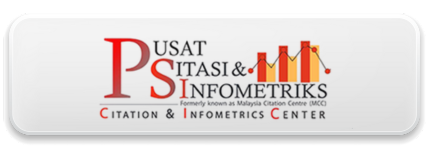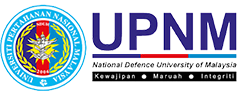Guideline for Authors
SUBMISSION
The Journal publishes manuscripts written in English and Bahasa Malaysia. Manuscripts submitted to the journal for publication should be original contributions and must not have been previously published or are under consideration simultaneously by any other publication. The manuscript should be typed with single spacing, a single column in Cambria with font size 10 on A4 paper size.
Please use this template: ZULFAQAR JDSET Template
FORMAT AND STYLE
Title and Authorship Information:
Title page should start with the type of manuscript (Research, Review Article, Short Communications, etc). This should be concise, short, specific and explain the nature of the work. The names of all authors (first name, middle initial, last name) including their departmental and institutional addresses should also be included. The name of the corresponding author along with E-mail should be provided. An asterisk (*) should be added to the right of the corresponding author’s name. His or her affiliation should be indicated by superscripts a, b, c,…… placed after each author’s name and before each affiliation.
Abstract:
The manuscript should contain an abstract. The abstract should be self-contained and citation-free and should not exceed 200 words. The abstract should state the purpose, approach, results, and conclusions of the work. The author should assume that the reader has some knowledge of the subject but has not read the paper. Thus, the abstract should be intelligible and complete in itself (no numerical references); it should not cite figures, tables, or sections of the paper. The abstract should be written using the third person instead of the first person.
Keywords:
Immediately after the abstract, up to five (5) keywords should be provided, which will be used for indexing purposes. Keywords should be separated by commas and words from the title should avoid repeating as keywords.
Introduction:
This should provide an adequate background and general context for the work, explaining its significance, and indicating why it should be of interest to researchers. Avoiding a detailed literature survey or a summary of the results. State the objectives of the study at the end of this section.
Materials and Methods:
Graphs and other numbered figures should appear throughout the text as close to their mention as possible. Figures shouldn’t infringe upon the page borders.
Figures and tables must be centered in the column. Large figures and tables can be in one column to see them more clearly and avoid placing them in the middle of columns. Any table or figure that takes up more than 1 column width must be positioned either at the top or at the bottom of the page. Photos must be crystal clear with such resolution to allow fine details visibility. The elements from any photo must be explained using numbers, letters, etc. The text within a figure or photo must have the same style, shape, and height as the caption.
Results:
Merging the Results and Discussion parts into a single section is suitable. Precise and clear outcomes are necessary. The importance of the research findings should be thoroughly highlighted throughout the discussion section. Avoid using extensive citations and discussing previously published material.
Discussion:
Discussion should be able to interpret the results clearly and concisely in relation to previous findings, whether in support, against, or simply as added data to provide the reader with a broad base on which to accept or reject the hypotheses tested. A combined Results and Discussion section is often appropriate.
Conclusions:
Authors are required to conclude the outcomes of their research by providing a concise overview of the introductory phrase, key points of the original text, and supporting arguments.
Conflict of Interest:
The manuscript should provide full disclosure of any financial or non-financial interests, including political, personal, or professional affiliations, that could be perceived as having impacted its content. If there is no conflict of interest, the line "The authors declare no conflicts of interest" should be included.
Authors Contribution:
Authors are advised to submit an author statement file that outlines their individual contributions to the paper using the relevant author contribution roles in order to enhance transparency. The primary author bears the responsibility of ensuring that other authors are in agreement regarding the accuracy of the descriptions. It is necessary to specify the duties of all authors, using the suitable categories below. Authors may have fulfilled a diverse range of roles in their contributions. Author contributions do not influence the criteria for authorship set by the publication. The subsequent terms are employed to characterise author contributions.
Conceptualisation; Methodology; Validation; Formal analysis; Data curation; Formal analysis; Investigation; Resources; Software; Visualisation; Writing - original draft; Writing - review & editing; Funding acquisition; Project administration; Supervision.
Authorship statements should be presented with the authors' names listed first, followed by their respective author contribution role(s), such as
First, J. A. (Conceptualization; Methodology; Formal analysis)
Second, J. A. (Resources; Software; Data curation; Writing - original draft; Resources)
Third, J. A. (Writing - original draft; Project administration; Supervision)
Acknowledgment:
This section should provide a comprehensive overview of the many sources of funding that have been utilised to support the effort. Please provide a description of the involvement of the study sponsor(s), if any, in the study's design, data collecting, analysis, interpretation, article authoring, and decision to submit it for publication. The acknowledgment of personal help should be presented as a distinct paragraph. Individuals who have made contributions to the work but do not meet the criteria for authorship should be listed, along with a description of their specific contributions. It is imperative to obtain consent from individuals mentioned in the acknowledgments before including their names. Standardise the formatting of funding sources to ensure compliance with the needs of the funder.
Funding
The following statement should be included if there is funding available for the research:
“This research is fully supported by [type of grant], [grant numbers]. The authors fully acknowledge [name of funding sources] for the approved fund which makes this important research viable and effective.”
The following statement should be included if there is no funding available for the research:
“This study was not supported by any grants from funding bodies in the public, private, or not-for-profit sectors.”
References:
In-text Reference Citations
Examples of in-text citations:
"...end of the line for my research [13]."
"This theory was first put forward in 1987 [1]."
"Scholtz [2] has argued that..."
"Several recent studies [3-4, 15-16] have suggested that...."
List of Reference
[1] The contents must contain relevant and current references. The text should include a numbered list of all references using square brackets, and the reference section should present the references in the same numerical order. To prevent misunderstanding, multiple citations within the square brackets should be separated by commas. If there are more than two consecutive references, it is essential to include ranges.
[2] The title, headers, and abstract of the document should not contain reference citations. It is recommended that the reference list be formatted exclusively by the APA Style.
[3] Citation manipulation is the act of repeatedly citing an author's study in order to purposely boost the number of citations for their work (COPE, 2019). Zulfaqar JDSET journal strongly advises writers to limit self-citation to prevent citation manipulation. The Zulfaqar JDSET journal strongly recommends limiting the number of self-citations in any article to a maximum of 5 (including jointly authored papers) or 20 percent, whichever is less.
COPYRIGHT
It is the author's responsibility to ensure that his or her submitted work does not infringe any existing copyright. Authors should obtain permission to reproduce or adapt copyrighted material and provide evidence of approval upon submitting the final version of a manuscript.
REVIEW PROCESS
Manuscripts will be reviewed by the Editorial Board and at least two (2) single blind independent reviewers. Decisions regarding the publication of a manuscript will be based on the Board's recommendations. The manuscript will be evaluated based on its appropriateness for JDSET, contribution to the discipline, cogency of analysis, conceptual breadth, clarity of presentation and technical adequacy. Manuscripts submitted by members of the journal's Editorial Board are subjected to the same review procedure.
PROOFS
One set of proofs will be sent to the author(s) to be checked for printer's errors and it is the responsibility of the author(s) to submit corrections to the Editorial Board.
DISCLAIMER
Opinions expressed in the journal are solely those of the authors and do not necessarily reflect the views of the editors, or the publisher. Material published in the JDSET is copyrighted in its favour. As such, no part of this publication may be reproduced or transmitted in any form or by any means, electronic or mechanical, including photocopying, or any information retrieval system, without permission in writing from the publisher.







